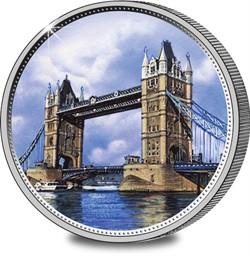-no-button.jpg)
 |
Location: North Bank of River Thames, adjacent to City
of London
Date completed: 1894
Designers/builders: Sir Horace Jones
Function: River crossing
|
Tower Bridge, which crosses the Thames near the Tower of London,
is probably one of the world's most distinctive and best known
bridges. It is as much a symbol of London as Big Ben or Buckingham
Palace. Despite its elaborate gothic revival appearance, it dates
only from 1894 and is essentially a very efficient, high-tech (for
its time) steel and concrete structure. Prior to its construction,
the last down-river crossing was London Bridge, some way up stream.
As London expanded and industrialised eastwards, the need for
another downstream crossing became acute. The problem was that a
conventional bridge would block access by tall ships to the Pool of
London, downstream of London Bridge. In 1877 the government formed
"A Special Bridge or Subway Committee" to solve the problem, but it
was not until 1884 that a design was chosen. This was submitted by
Sir Horace Jones (one of the judges). The design centred on two
great towers, built on piers sunk into the river, anchored and
braced at the top by walkways. The road crossing was split into two
bascules (tilting sections) which could be raised by hydraulic
steam engines to allow tall-masted ships to pass through. The two
side spans were suspension bridges. Overall, the Bridge is 800 ft
(244 m) long with a central span of 200 ft (61 m). The two bascules
can be raised to a maximum angle of 86 degrees - the precise degree
depends on the height of the ship passing beneath, although the
bascules are always raised to the full height for a craft with the
reigning monarch on board, regardless of size.
Starting in 1886 it took eight years to complete Tower Bridge.
First more than 70,000 tons of concrete needed to be sunk into the
river bed to provide piers for the towers to stand on. The
framework of the towers was made up of 11,000 tons of steel, which
was clad in Cornish Granite and Portland stone. The tower was
originally to have been clad in brick, but this was changed to its
present ornate Gothic style, to harmonise with the nearby Tower of
London.